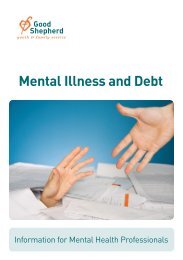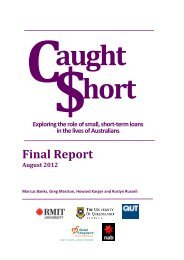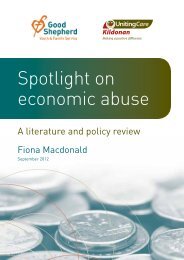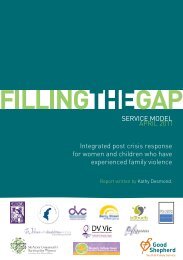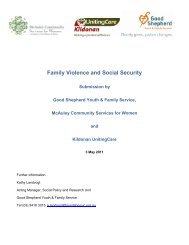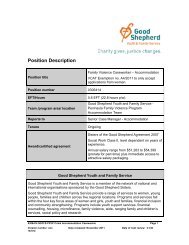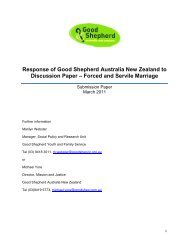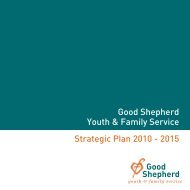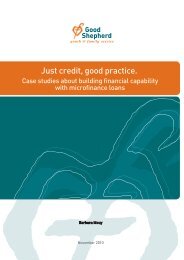Spotlight on economic abuse - Good Shepherd Youth & Family ...
Spotlight on economic abuse - Good Shepherd Youth & Family ...
Spotlight on economic abuse - Good Shepherd Youth & Family ...
You also want an ePaper? Increase the reach of your titles
YUMPU automatically turns print PDFs into web optimized ePapers that Google loves.
The establishment of a Nati<strong>on</strong>al Council to Reduce Violence Against Women and Children in<br />
2008 was followed by the development and endorsement by the Comm<strong>on</strong>wealth, states and<br />
territories—through the Council of Australian Governments (COAG)—of the Nati<strong>on</strong>al Plan to<br />
Reduce Violence Against Women and their Children, 2010-2022 (the Nati<strong>on</strong>al Plan) (COAG<br />
2009). This represents a significant development as Australia’s first nati<strong>on</strong>al resp<strong>on</strong>se to<br />
violence against women.<br />
The Nati<strong>on</strong>al Plan does not name ec<strong>on</strong>omic <strong>abuse</strong> as a form of domestic violence, possibly<br />
reflecting the fact that ec<strong>on</strong>omic <strong>abuse</strong> is not recognised in family violence law in all<br />
Australian states and territories (see Secti<strong>on</strong> 5 below). However, in defining domestic<br />
violence the Nati<strong>on</strong>al Plan does include “c<strong>on</strong>trol of finances” as an example of c<strong>on</strong>trolling<br />
behaviours which are psychological and emoti<strong>on</strong>al <strong>abuse</strong> (COAG 2010, p. 2), which also<br />
reflects the approach taken in recent change to federal family law (also discussed in Secti<strong>on</strong><br />
5 below). Interventi<strong>on</strong>s identified in the Nati<strong>on</strong>al Plan relating directly to ec<strong>on</strong>omic <strong>abuse</strong> and<br />
its c<strong>on</strong>sequences are:<br />
primary interventi<strong>on</strong>s at the societal level promoting ec<strong>on</strong>omic equality and building<br />
an evidence base<br />
sec<strong>on</strong>dary interventi<strong>on</strong>s including informati<strong>on</strong> strategies for newly arrived migrant<br />
women and improving workplace supports.<br />
The outcomes identified in the Nati<strong>on</strong>al Plan include changes in community attitudes as well<br />
as improved services and justice. 5 There is c<strong>on</strong>siderable emphasis <strong>on</strong> primary preventi<strong>on</strong><br />
through community involvement and educati<strong>on</strong>. However, there may be limited potential for<br />
the Nati<strong>on</strong>al Plan to facilitate increased awareness of the variety of forms of <strong>abuse</strong> that<br />
c<strong>on</strong>stitute domestic and family violence as strategies for changing attitudes do not explicitly<br />
identify this as a goal.<br />
There is some recogniti<strong>on</strong> of the significance of gender inequality and women’s ec<strong>on</strong>omic<br />
security in the Nati<strong>on</strong>al Plan with “the advancement of gender equality” am<strong>on</strong>g the 18<br />
strategies identified (COAG 2010, p. 16). The specific interventi<strong>on</strong>s (mainly for the Australian<br />
Government) for the first three years of this particular strategy are mostly directed to<br />
achieving ec<strong>on</strong>omic equality for women. For 2010 to 2013, these interventi<strong>on</strong>s are:<br />
measures to increase women’s ec<strong>on</strong>omic security, including paid parental leave,<br />
superannuati<strong>on</strong> reform and increased support for pensi<strong>on</strong>ers<br />
measures to increase women’s leadership opportunities<br />
the provisi<strong>on</strong> of informati<strong>on</strong> about protecti<strong>on</strong>s for women who experience violence to<br />
newly arrived migrants and refugees<br />
c<strong>on</strong>sultati<strong>on</strong> with peak employer and employee representatives to improve ways for<br />
workplaces to better support women experiencing domestic violence<br />
funding the ADFVC Domestic Violence Workplace Rights and Entitlements project.<br />
One other strategy in the Nati<strong>on</strong>al Plan explicitly addresses the ec<strong>on</strong>omic impacts of<br />
domestic and family violence; this is a tertiary interventi<strong>on</strong> which is to “support mainstream<br />
services to identify and resp<strong>on</strong>d to needs”, a strategy which is presented as resp<strong>on</strong>ding to<br />
the needs for women and children “to receive holistic support including health, housing,<br />
educati<strong>on</strong>, employment and legal assistance” (COAG 2010, pp. 23-24). Interventi<strong>on</strong>s in the<br />
short-term include the provisi<strong>on</strong> of homelessness services to improve housing opti<strong>on</strong>s for<br />
women and funding of income support and family assistance payments, including the crisis<br />
payment for women experiencing violence; other interventi<strong>on</strong>s mainly target the health<br />
sector and health workers. One other highly relevant strategy in the Nati<strong>on</strong>al Plan relates to<br />
5 Appendix A of this paper provides more detail of the outcomes identified in the Nati<strong>on</strong>al Plan.<br />
25



